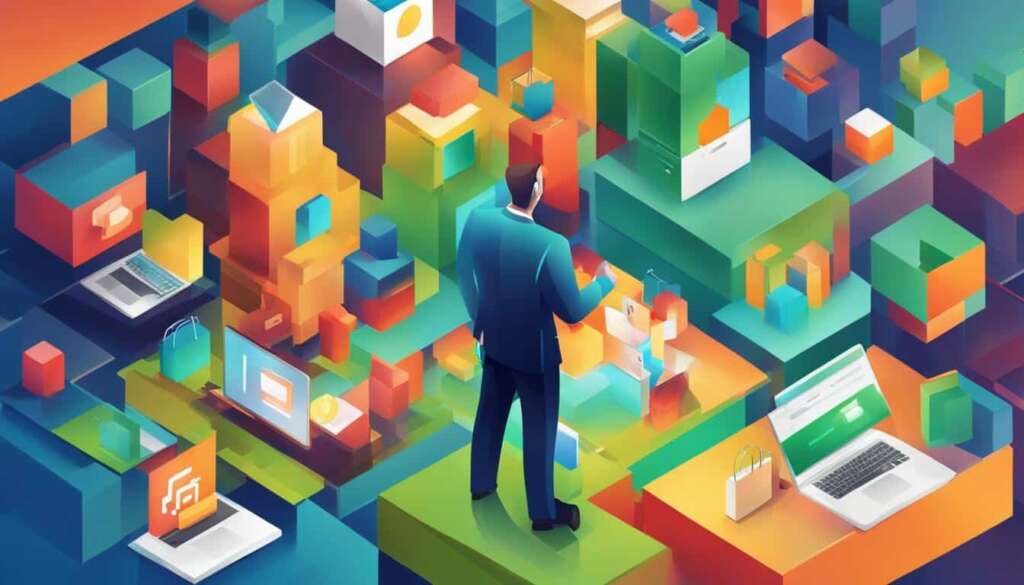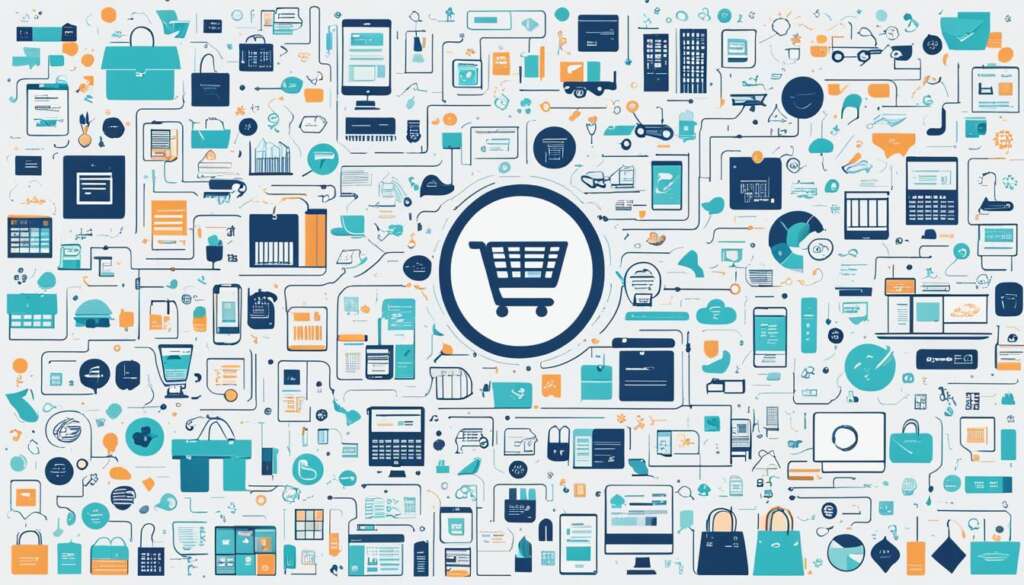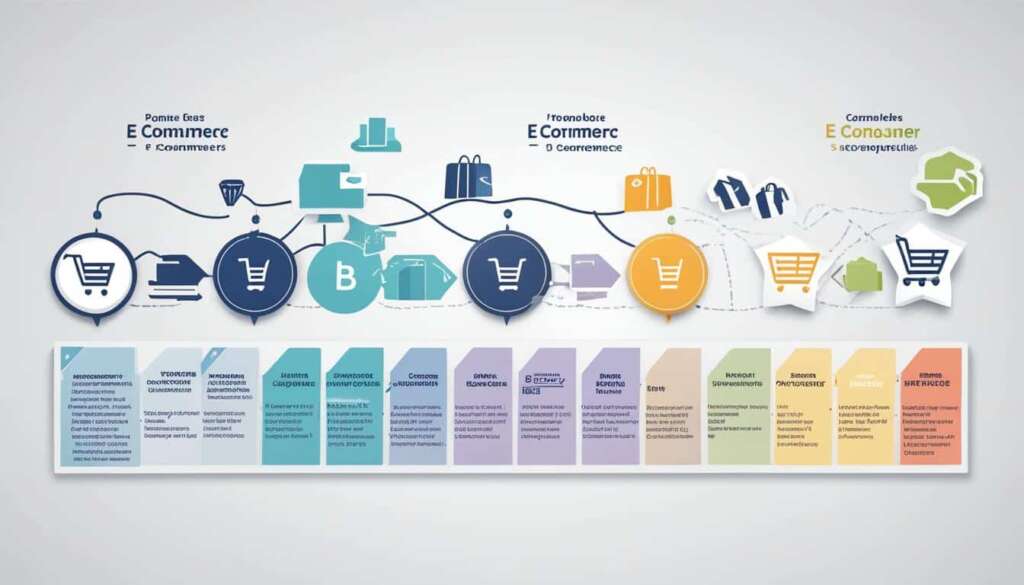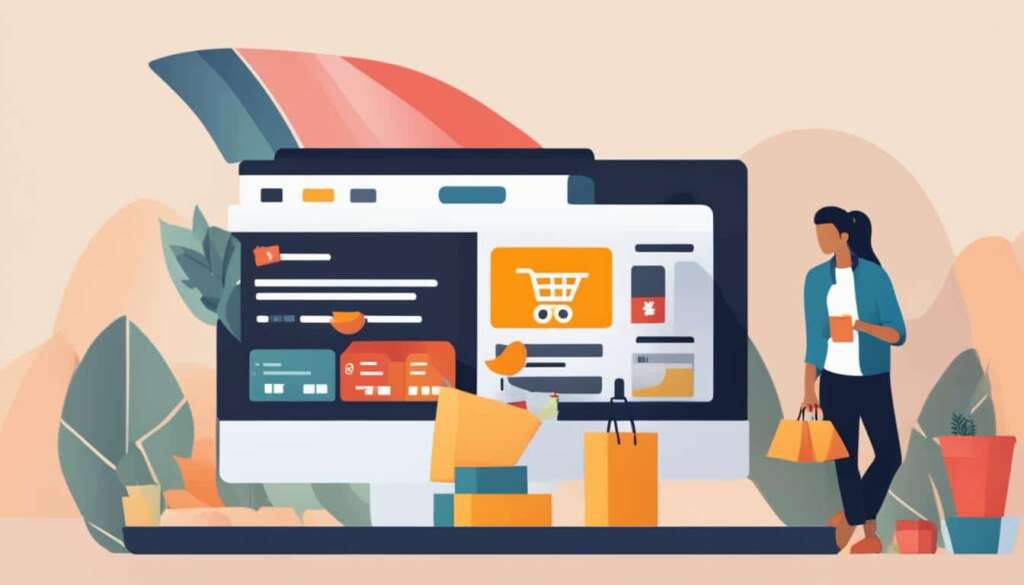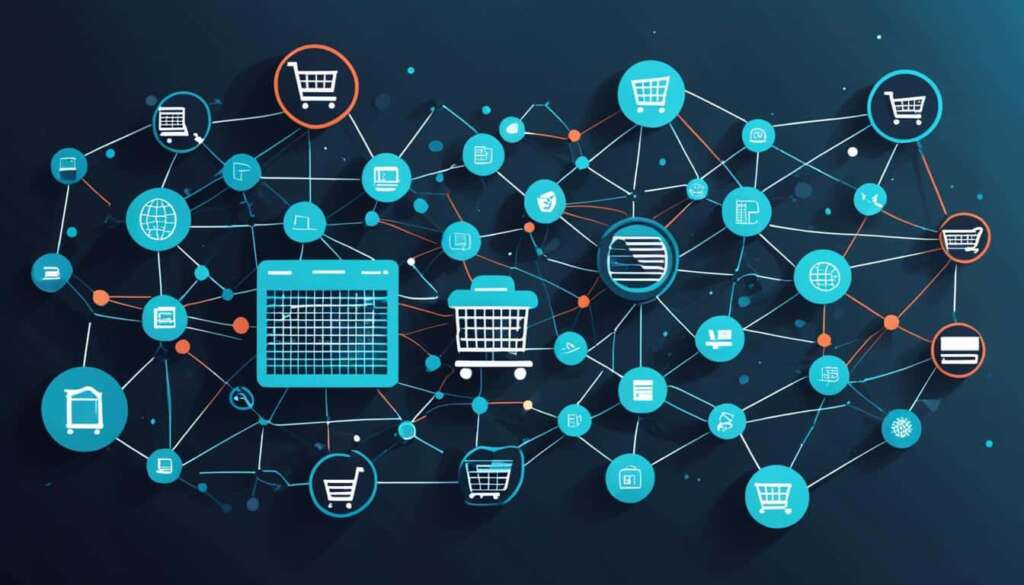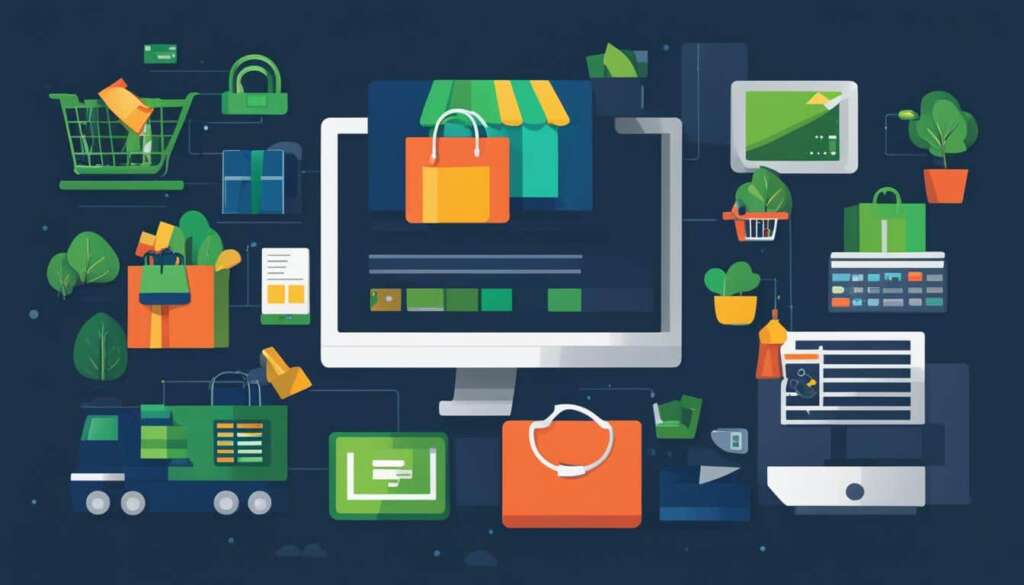Table of Contents
In 2023, e-commerce is projected to make up about 20% of overall global retail sales. Deciding on a suitable e-commerce business model is one of the first and most important steps in achieving success in the online retail industry. With the rise of the digital marketplace, businesses need to carefully evaluate their options to ensure they can effectively cater to their target market and meet their long-term growth objectives.
There are six major e-commerce business models worth exploring: Business to Consumer (B2C), Business to Business (B2B), Business to Government (B2G), Business to Business to Consumer (B2B2C), Consumer to Business (C2B), and Consumer to Consumer (C2C). Each model has its own unique features, advantages, and challenges.
When considering an e-commerce business model, it’s essential to think about factors such as the characteristics of your target audience, the nature of your products or services, and your overall growth strategy. By making an informed decision, you can position your online retail business for success in the dynamic and evolving digital marketplace.
eCommerce Business Models: Business to Consumer (B2C)
Business to Consumer (B2C) is the most widely known model, where a company sells its products or services directly to end users. B2C eCommerce has experienced significant growth in recent years, as traditional brick-and-mortar retailers have recognized the importance of online channels in reaching consumers. This model is characterized by personalized marketing strategies and a focus on providing a seamless online shopping experience. Let’s explore the different subsets of the B2C model and understand why it is crucial for B2C businesses to have an adaptable eCommerce platform.
Subsets of the B2C Model
The B2C model can be further divided into five different subsets:
- DTC eCommerce: Direct-to-Consumer (DTC) eCommerce refers to companies that sell their products directly to customers without involving any intermediaries. This allows brands to have more control over their product offerings and customer relationships.
- Online Intermediaries: Online intermediaries act as a bridge between the company and the end consumer. Popular online marketplaces like Amazon and eBay connect sellers with buyers and provide a platform for businesses to reach a wider customer base.
- Advertising-based Models: Advertising-based models generate revenue by displaying advertisements on their platform. These advertisements can be targeted based on user preferences, ensuring that consumers see personalized and relevant advertisements while browsing.
- Community-based Sites: Community-based sites focus on building a community of customers with shared interests and preferences. These platforms provide a space for users to engage with each other, share reviews, recommendations, and product insights.
- Fee-based Models: Fee-based models involve charging customers a subscription fee or membership fee to access exclusive content, products, or services. This model creates a sense of exclusivity and enhances customer loyalty.
The Growth of B2C eCommerce
B2C eCommerce has witnessed remarkable growth due to the convenience and accessibility it offers to consumers. Online shopping has become a preferred method for purchasing products and services, with consumers enjoying the convenience of browsing through a wide range of options, comparing prices, and making purchases from the comfort of their homes. The COVID-19 pandemic has further accelerated this trend, as lockdowns and social distancing measures have pushed more consumers towards online shopping.
For traditional retailers, embracing B2C eCommerce has become imperative for staying competitive in the market. Brands that have successfully integrated their online and offline channels can provide a seamless shopping experience, allowing customers to switch between online and physical stores seamlessly. This omnichannel approach ensures that businesses can cater to the diverse preferences of their customers.
Personalized Marketing in B2C eCommerce
One of the key advantages of B2C eCommerce is the ability to deliver personalized marketing experiences to individual customers. Personalized marketing involves tailoring product recommendations, offers, and communication based on customer demographics, preferences, and purchasing history. By leveraging customer data and advanced analytics, businesses can create targeted marketing campaigns that resonate with their target audience.
Personalized marketing can significantly enhance customer satisfaction and drive repeat purchases. When customers receive relevant product recommendations and exclusive offers, they feel valued and understood by the brand. This level of personalization fosters a strong sense of brand loyalty, leading to increased customer lifetime value.
“Personalization is no longer a nice-to-have but a must-have in the B2C eCommerce space. By offering tailored experiences to customers, businesses can create meaningful connections and drive higher customer engagement.” – Sarah Miller, eCommerce Expert
Adapting to Customer Needs
In the highly competitive world of B2C eCommerce, it is crucial for businesses to have an eCommerce platform that can adapt to evolving customer needs. Customer expectations are constantly changing, driven by technological advancements and evolving market trends. An adaptable eCommerce platform can provide features such as mobile responsiveness, fast loading times, intuitive navigation, and secure payment options.
By staying updated with the latest trends in the industry and investing in technologies that enhance the user experience, B2C businesses can stay ahead of the competition and deliver exceptional customer satisfaction.
eCommerce Business Models: Business to Business (B2B)
In the world of eCommerce, Business to Business (B2B) refers to the practice of companies marketing their products or services directly to other businesses. B2B eCommerce can be approached in two distinctive ways: vertical and horizontal methodologies.
Vertically oriented businesses focus on catering to customers within a specific industry, providing tailored solutions and specialized expertise. This vertical approach allows businesses to position themselves as industry leaders and build a deep understanding of their customers’ unique needs and challenges.
On the other hand, the horizontal approach in B2B eCommerce involves selling products and services to customers across multiple industries. This broader scope enables businesses to reach a wider audience and capitalize on different market segments. With a horizontal approach, companies can leverage their expertise and offerings to cater to diverse business needs and create new opportunities for growth.
Historically, the B2B sector has been slower to adopt digital strategies compared to B2C. However, in recent years, there has been a notable shift towards embracing eCommerce in B2B, with digital commerce initiatives surpassing those of B2C counterparts.
B2B brands have recognized the significance of digital transformation, driven by consumer demands and ever-increasing expectations. By integrating B2B eCommerce into their operations, businesses can enhance efficiency, streamline processes, and open doors to a global customer base.
Benefits of B2B eCommerce
Utilizing B2B eCommerce offers a wide range of benefits for businesses, including:
- Improved customer experience: B2B eCommerce platforms provide a seamless and user-friendly shopping experience, allowing businesses to meet customer expectations in a digital-first world.
- Increased operational efficiency: Streamlining purchasing processes and automating transactions result in time and cost savings for both buyers and sellers.
- Expanded market reach: B2B eCommerce enables businesses to tap into new markets beyond geographical boundaries, reaching customers worldwide.
- Enhanced customer insights: Digital channels provide valuable data and analytics, enabling businesses to gain deeper insights into customer preferences, behaviors, and trends.
- Personalized marketing strategies: B2B eCommerce facilitates targeted marketing campaigns and tailored product recommendations based on individual customer needs and preferences.
As B2B eCommerce continues to evolve, businesses must embrace this transformative shift to stay competitive in the ever-changing digital landscape. By choosing the most suitable eCommerce business model, businesses can effectively adapt to customer demands, unlock new growth opportunities, and achieve success in the B2B marketplace.
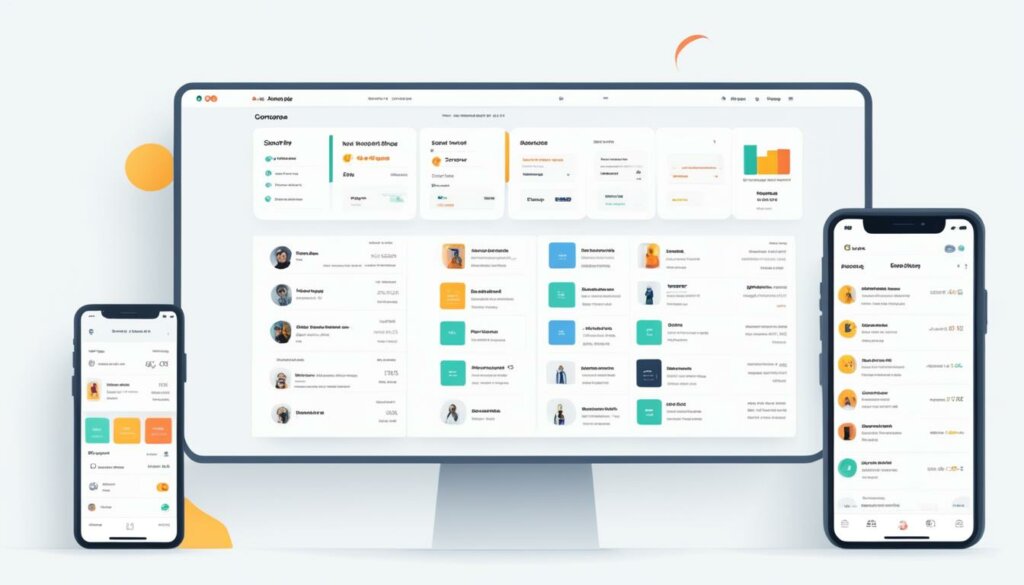
| Vertical-oriented Approach: | Horizontal Approach: |
|---|---|
| Sells to customers within a specific industry. | Sells to customers across multiple industries. |
| Provides tailored solutions and specialized expertise. | Reaches a wider audience and capitalizes on different market segments. |
| Creates a deep understanding of customers’ unique needs. | Expands reach and creates new growth opportunities. |
eCommerce Business Models: Business to Government (B2G)
In the world of eCommerce, there is a unique business model known as Business to Government (B2G). This model involves companies directly marketing their products and services to government agencies at various levels, including local, county, state, or federal. B2G eCommerce is primarily driven by bidding for government contracts, and the decision-making process in this sector often moves slower compared to other industries.
When engaging in B2G eCommerce, businesses may sell products directly to governments or offer services for government projects. However, it is essential to understand the distinctive dynamics of working with government agencies. Companies must be prepared for potential challenges that may arise, such as longer sales cycles and bureaucratic processes.
However, despite the challenges, B2G eCommerce offers significant opportunities for businesses in terms of revenue and growth. Government contracts provide a stable and reliable source of income, while also allowing companies to contribute to public projects and initiatives.
To navigate the world of B2G eCommerce successfully, businesses must have a comprehensive understanding of the procurement process. RFPs, or Request for Proposals, are the primary method through which government agencies solicit bids for projects. Companies must familiarize themselves with this process to effectively compete for government contracts.
“B2G eCommerce provides unique challenges and rewards. By understanding the government procurement process and being prepared to navigate bureaucratic processes, businesses can unlock lucrative opportunities and make meaningful contributions to public projects.” – Sarah Thompson, Government Contract Expert
B2G eCommerce is an industry that offers immense potential, and businesses aiming to operate within this model must equip themselves with the necessary knowledge and resources. By doing so, they can position themselves as trusted partners to government agencies and secure lucrative contracts that fuel their growth and success.
| Consideration | Impact |
|---|---|
| Bidding for Government Contracts | Access to stable income streams, long sales cycles |
| Understanding Government Procurement | Ability to compete effectively for contracts, navigating bureaucratic processes |
| Long-Term Partnership Potential | Opportunity to establish solid relationships with government agencies |
By carefully considering and addressing these key factors, businesses can unlock the potential of B2G eCommerce and establish themselves as trusted partners to government agencies.
eCommerce Business Models: Business to Business to Consumer (B2B2C)
In B2B2C eCommerce, one business sells products, services, or goods to another company, which then sells to the end consumer. This model involves three actors: the business of product origin, an intermediary, and the end user or consumer. B2B2C eCommerce can take various forms, such as partnering with another company to promote products and services or offering commissions for sales. This model provides an opportunity for businesses to acquire new customers and expand their customer base rapidly.
By forming partnerships and collaborations, businesses can leverage the resources, expertise, and customer base of an intermediary to reach a wider audience. These intermediaries can be online marketplaces, wholesalers, or retailers that act as a bridge between the business of product origin and the end consumer.
For example, Company A, a manufacturer of sports equipment, partners with Company B, a well-established online marketplace. Company A provides their products to Company B, who then showcases and sells these products to the end consumers on their platform. This partnership allows Company A to tap into Company B’s existing customer base and benefit from their marketing and distribution capabilities.
In the B2B2C model, businesses can also offer commissions or incentives to intermediaries for driving sales. This incentivizes intermediaries to actively promote and market the products or services, increasing the chances of reaching potential end consumers. By compensating intermediaries for their efforts, businesses can forge mutually beneficial relationships and drive sales growth.
Benefits of B2B2C eCommerce
- Expanded reach: By partnering with an intermediary, businesses can access a wider customer base and reach new markets.
- Increased brand exposure: Collaborating with established intermediaries allows businesses to enhance their brand visibility and gain credibility.
- Streamlined distribution: Leveraging an intermediary’s logistics and distribution network enables businesses to efficiently deliver products to end consumers.
- Shared marketing efforts: Intermediaries often have robust marketing strategies in place, which businesses can leverage to promote their products and services.
- Rapid customer acquisition: Through partnerships and collaborations, businesses can quickly acquire new customers and expand their customer base.
By adopting the B2B2C eCommerce model, businesses can harness the power of partnerships and intermediaries to accelerate growth, increase sales, and enhance customer satisfaction. However, it’s essential for businesses to carefully choose their partners, establish clear agreements, and maintain open communication channels to ensure a successful collaboration.
eCommerce Business Models: Consumer to Business (C2B)
The Consumer to Business (C2B) eCommerce model is a reverse approach where individuals have the opportunity to sell goods or services directly to companies. In recent years, this model has gained significant popularity, thanks to the emergence of freelancing platforms and influencer marketing platforms.
Freelancing platforms like Upwork have revolutionized the way businesses connect with freelancers. These platforms provide a marketplace for individuals to showcase their skills and expertise in various fields such as graphic design, writing, programming, and more. Businesses can then hire these freelancers on a project basis, fulfilling their specific needs without the overhead costs of hiring full-time employees.
Another aspect of C2B eCommerce is influencer marketing. Influencer marketing platforms have created a space where companies can collaborate with individuals who have a significant online following and influence. These influencers can promote a company’s products or services to their audience, leveraging their credibility and reach to drive brand awareness and sales.
With influencer marketing, businesses can tap into an influencer’s loyal fan base, gaining access to a highly engaged audience. This can be especially beneficial for businesses targeting niche markets or looking to expand their customer base through word-of-mouth marketing.
One of the key advantages of C2B eCommerce is that it gives consumers the power to set prices or compete for business opportunities. This dynamic allows individuals to negotiate and dictate the terms of engagement with companies. It also provides a level playing field where anyone can participate and offer their services or products, regardless of industry experience or company size.
However, businesses engaging in C2B eCommerce need to carefully manage quality control and ensure consistent delivery of goods and services. Maintaining standards and meeting customer expectations is crucial for building trust and reputation in the online marketplace.
The Influence of C2B eCommerce in the Digital Landscape
C2B eCommerce has significantly disrupted traditional business models, providing individuals with new opportunities to monetize their skills and expertise. This model has fostered a freelance economy, allowing individuals to work on their terms and choose the projects that align with their interests and abilities.
Furthermore, C2B eCommerce has empowered individuals to become the content creators and key decision-makers in the online business ecosystem. This shift in power and influence has opened up doors for innovation, creativity, and entrepreneurship, blurring the lines between consumers and businesses.
Comparison of eCommerce Business Models
| eCommerce Business Models | Advantages | Challenges |
|---|---|---|
| B2C | Direct access to end consumers, personalized marketing | Intense competition, customer acquisition costs |
| B2B | Large order volumes, long-term partnerships | Complex sales cycles, industry-specific challenges |
| B2G | Potential government contracts, stable revenue stream | Bureaucratic processes, slower decision-making |
| B2B2C | Expanded customer base, product promotion opportunities | Cooperation and trust management, intermediary dependence |
| C2B | Flexibility for freelancers, influencer marketing opportunities | Quality control, consistent service delivery |
| C2C | Wide variety of products, flexible pricing options | Maintaining quality, technology maintenance |

C2B eCommerce has transformed the relationship between individuals and businesses, enabling a collaborative and mutually beneficial exchange. With the rise of freelancing platforms and influencer marketing platforms, individuals have become active contributors to the business ecosystem, offering their skills and expertise to companies in novel ways.
Businesses entering the realm of C2B eCommerce must navigate the challenges of quality control and consistent service delivery to build trust and maintain customer satisfaction. However, when managed effectively, C2B eCommerce opens up new avenues for innovation, creativity, and business growth in the digital age.
eCommerce Business Models: Consumer to Consumer (C2C)
In the world of eCommerce, consumer-to-consumer (C2C) transactions play a significant role. This model enables consumers to sell their goods or services directly to other consumers, without the need for intermediaries. Online marketplaces like eBay and Craigslist serve as platforms that facilitate these peer-to-peer transactions. With C2C eCommerce, individuals and hobbyists can easily monetize their assets, turning unused items into a source of income.
One of the advantages of C2C eCommerce is the wide range of products available. It allows buyers to access unique items or find exclusive deals that may not be available through traditional retail channels. Additionally, C2C eCommerce offers flexible pricing options, as sellers can set their own prices based on supply and demand dynamics. This creates an environment where motivated buyers and sellers can negotiate and find mutually beneficial agreements.
However, C2C eCommerce also presents challenges related to quality control and technology maintenance. Since individuals are responsible for listing and selling their products, ensuring the accuracy of product descriptions and images can be a concern. Moreover, maintaining the functionality and security of online marketplaces requires continuous updates and robust cybersecurity measures.
Advantages of C2C eCommerce:
- Access to a wide range of products
- Flexible pricing options
- Opportunities for unique and exclusive deals
Challenges of C2C eCommerce:
- Quality control of product descriptions and images
- Technology maintenance and cybersecurity
Overall, C2C eCommerce has revolutionized the way individuals buy and sell products, transforming peer-to-peer transactions into a viable business model. The convenience, variety, and economic benefits it offers make it a popular choice among consumers worldwide. However, it’s important for both buyers and sellers to exercise caution and use trusted platforms to ensure a safe and satisfactory experience.
E-commerce Business Models Comparison
| Business Model | Definition | Advantages | Challenges |
|---|---|---|---|
| B2C | Business to Consumer | Wide customer reach, personalized marketing | Competition, customer acquisition costs |
| B2B | Business to Business | Larger order volumes, long-term partnerships | Complex decision-making processes, limited customer base |
| B2G | Business to Government | Government contracts, stable demand | Lengthy sales cycles, bureaucratic processes |
| B2B2C | Business to Business to Consumer | Access to new customers, market expansion | Dependency on intermediaries, coordination challenges |
| C2B | Consumer to Business | Freedom to set prices, flexible work arrangements | Quality control, inconsistent service delivery |
| C2C | Consumer to Consumer | Access to a wide range of products, flexible pricing options | Quality control, technology maintenance |
Conclusion
Choosing the right eCommerce business model is crucial for online business success. It requires a comprehensive understanding of each model’s nuances and how they align with the brand’s vision, target audience, and product offerings. Factors such as market analysis, product type, financial resources, and business goals should be considered when selecting the optimal model.
Additionally, businesses should stay informed about emerging trends in the eCommerce industry, such as advancements in technology and evolving consumer behavior. By staying ahead of the curve, businesses can adapt their strategies and ensure they are meeting the changing needs and expectations of their customers.
Ultimately, customer satisfaction is key to the long-term success of any online business. By choosing the right eCommerce business model, businesses can create a seamless and enjoyable shopping experience, build strong customer relationships, and drive repeat purchases. With the right model and an unwavering focus on customer satisfaction, businesses can thrive in the dynamic and competitive world of eCommerce.
FAQ
What is an eCommerce business model?
An eCommerce business model is a framework or strategy that determines how a company sells its products or services online and interacts with customers.
How many eCommerce business models are there?
There are six major eCommerce business models: B2C, B2B, B2G, B2B2C, C2B, and C2C.
What is B2C eCommerce?
B2C eCommerce is a model where a company sells its products or services directly to end users.
What is B2B eCommerce?
B2B eCommerce is a model where a company markets its products or services directly to other businesses.
What is B2G eCommerce?
B2G eCommerce is a model where a company markets its products and services directly to government agencies at the local, county, state, or federal level.
What is B2B2C eCommerce?
B2B2C eCommerce is a model where one business sells products, services, or goods to another company, which then sells to the end consumer.
What is C2B eCommerce?
C2B eCommerce is a reverse model where individuals sell goods or services directly to companies.
What is C2C eCommerce?
C2C eCommerce involves consumers selling goods or services directly to other consumers.
How do I choose the right eCommerce business model?
To choose the right eCommerce business model, you need to consider factors such as your target market, product offerings, and long-term growth strategy.

